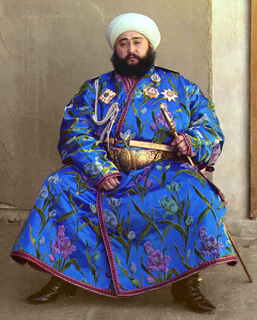 W
WThe abaya "cloak", sometimes also called an aba, is a simple, loose over-garment, essentially a robe-like dress, worn by some women in parts of the Muslim world including North East Africa, Somalia, Morocco, and the Arabian Peninsula. Traditional abayat are black and may be either a large square of fabric draped from the shoulders or head or a long kaftan. The abaya covers the whole body except the head, feet, and hands. It can be worn with the niqāb, a face veil covering all but the eyes. Some women also wear long black gloves, so their hands are covered as well. It is common that the abaya is worn on special occasions, such as Mosque visits and Islamic Holiday celebrations for Eid al-Fitr and Eid al-Adha.
 W
WAn agal, also spelled iqal, egal or igal, is an Arab mens' accessory. It is a black cord, worn doubled, used to keep a ghutrah in place on the wearer's head. It is traditionally made of goat hair.
 W
WBalgha, also spelled balga, belgha, or belga, are heelless slippers made from leather. They are part of traditional dress of the Muslim world and are related to Ancient Asia and the Chinese civilization.
 W
WBattoulah is a metallic-looking mask traditionally worn by Muslim Arab, Persian, and Baluch women in Arab states of the Persian Gulf, including Bahrain, Kuwait, Saudi Arabia, United Arab Emirates, Oman and Qatar, as well as in southern Iran. The origin of the battoulah is unknown, but it is thought to have entered the Eastern Arabian Peninsula from Gujarat in late 18th century.
 W
WA bisht or mishla or ʿabāʾ is a traditional Arab men’s cloak. It is a flowing outer cloak worn over a thawb.
 W
WThe djellaba or jillaba is a long, loose-fitting unisex outer robe with full sleeves that is worn in the Maghreb region of North Africa.
 W
WThe Fez, also called Tarboosh, is a felt headdress in the shape of a short cylindrical peakless hat, usually red, and sometimes with a tassel attached to the top. The name "Fez" refers to the Moroccan city of Fez, where the dye to colour the hat was extracted from crimson berries. The modern fez owes much of its popularity to the Ottoman era.
 W
WThe fouta is a piece of thin patterned cotton or linen fabric of Tunisian origin used in many Mediterranean countries and Yemen. Among other uses, they were worn, by both men and women, wrapped around the body while at the public baths in 19th-century Syria. In Algeria, conservative women wore the fouta draped over their sarouel garment. Similarly, in some parts of southern Saudi Arabia, men would wear the fouta as a loincloth beneath their thawb robes, or just by itself while relaxing at home. Foutas are widely used today in the occidental world as Turkish bath towels or even beach towels.
 W
WThe haik is a traditional women's garment worn in the Maghreb region. It is usually white. It consists of a rectangular fabric covering the whole body, 6 meters by 2.2 meters in length, rolled up then held at the waist by a belt and then brought back to the shoulders to be fixed by fibulae. It can be white or black.
 W
WAn izaar, also izar or ʾizār, also known as futah (فُوطَة), maʿawaz (مَعَوَز), wizarah (وِزَرَة), maqtab (مَقْطَب) is a traditional Yemeni clothing worn in Yemen especially by Hadhrami people who call it "saroun صارون" in their local dialect. It's a lower garment typically worn by men in Yemen, also known in United Arab Emirates, Iraq, Kuwait, Oman, Bahrain, Saudi Arabia and Qatar, and the Horn of Africa. Omani people typically wear a white izaar underneath the Thawb instead of sirwar pyjamas. Izaar like clothing is also worn in countries such as Indonesia, Malaysia, Bangladesh, Pakistan and countries in some parts of East Africa and in India. It is commonly worn by Yemenis at home, and work. In some parts of Arabia such as Yemen and the Jizan and ʿAsir regions of Saudi Arabia, it is known as futah instead. Some of these may feature tassels.
 W
WThe term jilbāb or jilbaab refers to any long and loose-fit coat or outer garment worn by some Muslim women. Wearers believe that this definition of jilbab fulfills the Quranic choice for a hijab. Jilbab, jubbah or jilaabah is also known as chador by Persian speakers in Iran and Afghanistan. The modern jilbāb covers the entire body. Some women will also cover the hands with gloves and the face along with a niqāb. In recent years, a short visor is often included to protect the face from the tropical sun.
 W
WA thawb or thobe, also called a Qamīṣ, is an ankle-length garment, usually with long sleeves, similar to a robe, kaftan or tunic. It is commonly worn in the Arabian Peninsula, Iraq, neighbouring Arab countries, the southern and south-western ports and islands of Iran, and some countries in East and West Africa. A sirwal or pants, izaar or lungi are typically worn underneath.
 W
WA kaftan or caftan is a variant of the robe or tunic, and has been worn in a number of cultures around the world for thousands of years and is of Asiatic origin. In Russian usage, kaftan instead refers to a style of men's long suit with tight sleeves. Used by many Middle Eastern ethnic groups, the kaftan is ancient Mesopotamian in origin. It may be made of wool, cashmere, silk, or cotton, and may be worn with a sash. Popular during the time of the Ottoman Empire, detailed and elaborately designed garments were given to ambassadors and other important guests at the Topkapi Palace. Variations of the kaftan were inherited by cultures throughout the Middle East and Asia and were worn by individuals in Russia, South East Asia and Northern Africa Styles, uses, and names for the kaftan vary from culture to culture. The kaftan is often worn as a coat or as an overdress, usually having long sleeves and reaching to the ankles. In regions with a warm climate, it is worn as a light-weight, loose-fitting garment. In some cultures, the kaftan has served as a symbol of royalty.
 W
WThe keffiyeh or kufiya also known as a ghutrah (غُترَة), shemagh, ḥaṭṭah (حَطَّة) or mashadah (مَشَدَة), is a traditional Arabian headdress, or what is sometimes called a habit, that originated in the Arabian Peninsula, and is now worn throughout the Middle East region. It is fashioned from a square scarf, and is usually made of cotton. The keffiyeh is commonly found in arid regions, as it provides protection from sunburn, dust and sand. Toward the end of the 1980s, the keffiyeh became a fashion accessory in the United States and, during the early 2000s it became very popular among teenagers in Tokyo, Japan, where it is often worn with camouflage-style clothing.
 W
WA niqāb or niqaab, also called a ruband, is a garment of clothing that covers the face, worn by some Muslim women as a part of a particular interpretation of hijab. The terms niqab and burqa are often confused; a niqab covers the face while leaving the eyes uncovered, while a burqa covers the entire body from the top of the head to the ground, with only a mesh screen allowing the wearer to see in front of her. According to the majority of Muslim scholars and Islamic schools of thought, face veiling is not a requirement of Islam; however a minority of Muslim scholars, particularly among the Sunni Wahabi movement, assert that women are required to cover their faces in public. Those Muslim women who wear the niqab do so in places where they may encounter non-mahram (non-related) men.
 W
WShayla is an Islamic head gear worn by some muslim women in the presence of any male outside of their immediate family. It is different from a khimar, because it is usually wrapped and pinned. Sometimes it is worn in the form of a half niqab with part of the face still appearing.
 W
WSirwal, also saroual, seroual, sarouel or serouel, also known, in some contexts, as Harem pants, are a form of baggy trousers predating the Christian era. They are typically worn in Muslim countries, but also extensively in the Greek countryside and other places in the Balkans that were influenced by Ottoman Turks prior to World War II. The trousers are not originally an Arab garment but were introduced from Persia to other Mideastern regions. The sirwal is also worn by communities in North India.
 W
WThe tantour (tantoor) was a form of cone-shaped woman's headdress similar to the hennin, popular in the Levant during the nineteenth century, but seldom seen after 1850.
 W
WThe taqiyah or araqchin, is a short, rounded skullcap. They are often worn for religious purposes; for example, Muslims believe that the Islamic prophet Muhammad used to keep his head covered, therefore making it mustahabb. Muslim men often wear them during the five daily prayers.
 W
WA thawb or thobe, also called a Qamīṣ, is an ankle-length garment, usually with long sleeves, similar to a robe, kaftan or tunic. It is commonly worn in the Arabian Peninsula, Iraq, neighbouring Arab countries, the southern and south-western ports and islands of Iran, and some countries in East and West Africa. A sirwal or pants, izaar or lungi are typically worn underneath.
 W
WTiraz are medieval Islamic embroideries, usually in the form of armbands sewn onto robes of honour (khilat). They were bestowed upon high-ranking officials who showed loyalty to the Caliphate, and given as gifts to distinguished individuals. They were usually inscribed with the ruler's names, and were embroidered with threads of precious metal and decorated with complex patterns. Tiraz were a symbol of power; their production and export were strictly regulated, and were overseen by a government-appointed official.
 W
WA turban is a type of headwear based on cloth winding. Featuring many variations, it is worn as customary headwear by people of various cultures. Communities with prominent turban-wearing traditions can be found in the Indian subcontinent, Southeast Asia, the Arabian Peninsula, the Middle East, the Balkans, the Caucasus, Central Asia, North Africa, West Africa, East Africa, and amongst some Turkic peoples in Russia as well as Ashkenazi Jews.